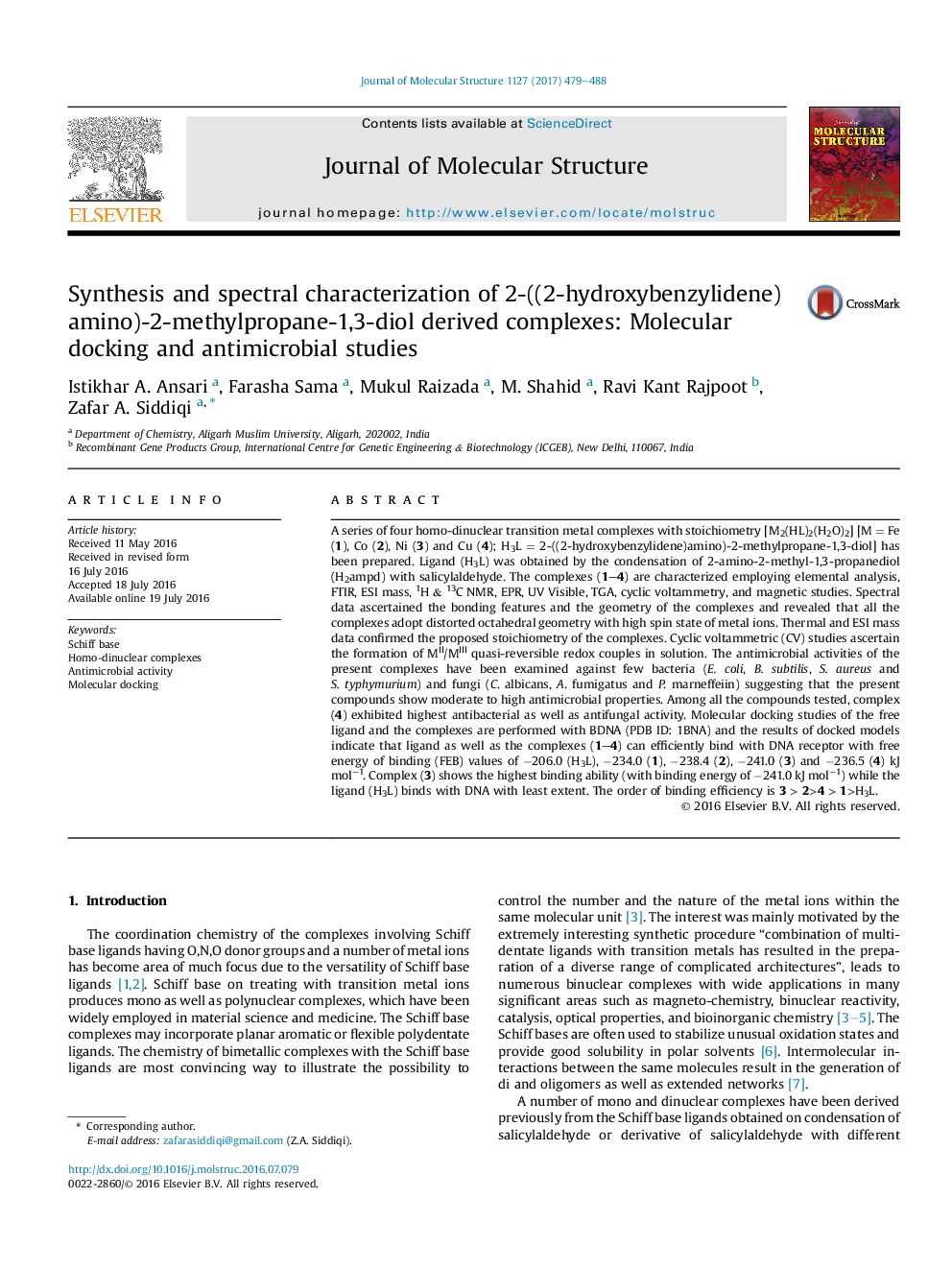| کد مقاله | کد نشریه | سال انتشار | مقاله انگلیسی | نسخه تمام متن |
|---|---|---|---|---|
| 1407557 | 1501690 | 2017 | 10 صفحه PDF | دانلود رایگان |
• Four homo-dinuclear complexes [M2(HL)2(H2O)2] [M = Fe, Co, Ni or Cu; H3L = 2-((2-hydroxybenzylidene)amino)-2-methylpropane-1,3-diol] are reported.
• Spectral data confirm distorted octahedral geometry with high spin state of metal ions.
• CV of the complexes ascertains the formation of MII/MIII quasi-reversible redox couples in solution.
• The antimicrobial activities and molecular docking studies are also examined.
A series of four homo-dinuclear transition metal complexes with stoichiometry [M2(HL)2(H2O)2] [M = Fe (1), Co (2), Ni (3) and Cu (4); H3L = 2-((2-hydroxybenzylidene)amino)-2-methylpropane-1,3-diol] has been prepared. Ligand (H3L) was obtained by the condensation of 2-amino-2-methyl-1,3-propanediol (H2ampd) with salicylaldehyde. The complexes (1–4) are characterized employing elemental analysis, FTIR, ESI mass, 1H & 13C NMR, EPR, UV Visible, TGA, cyclic voltammetry, and magnetic studies. Spectral data ascertained the bonding features and the geometry of the complexes and revealed that all the complexes adopt distorted octahedral geometry with high spin state of metal ions. Thermal and ESI mass data confirmed the proposed stoichiometry of the complexes. Cyclic voltammetric (CV) studies ascertain the formation of MII/MIII quasi-reversible redox couples in solution. The antimicrobial activities of the present complexes have been examined against few bacteria (E. coli, B. subtilis, S. aureus and S. typhymurium) and fungi (C. albicans, A. fumigatus and P. marneffeiin) suggesting that the present compounds show moderate to high antimicrobial properties. Among all the compounds tested, complex (4) exhibited highest antibacterial as well as antifungal activity. Molecular docking studies of the free ligand and the complexes are performed with BDNA (PDB ID: 1BNA) and the results of docked models indicate that ligand as well as the complexes (1–4) can efficiently bind with DNA receptor with free energy of binding (FEB) values of −206.0 (H3L), −234.0 (1), −238.4 (2), −241.0 (3) and −236.5 (4) kJ mol−1. Complex (3) shows the highest binding ability (with binding energy of −241.0 kJ mol−1) while the ligand (H3L) binds with DNA with least extent. The order of binding efficiency is 3 > 2>4 > 1>H3L.
A Schiff base ligand, 2-((2-hydroxybenzylidene)amino)-2-methylpropane-1,3-diol] and its four complexes with transition metal ions have been prepared and characterized employing elemental analysis, FTIR, ESI mass, 1H & 13C NMR, EPR, UV Visible, TGA, cyclic voltammetry, and magnetic studies. The antimicrobial activity data of the present complexes, screened against a number of bacteria and fungi suggest that the present compounds show moderate to high antimicrobial properties. Molecular docking studies of the free ligand and the complexes are performed with BDNA (PDB id: 1BNA) and the results reveal the order of binding efficiency to be 3 > 2>4 > 1>H3L.Figure optionsDownload as PowerPoint slide
Journal: Journal of Molecular Structure - Volume 1127, 5 January 2017, Pages 479–488
